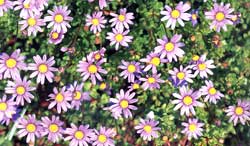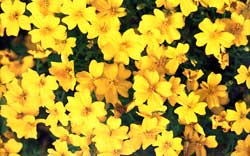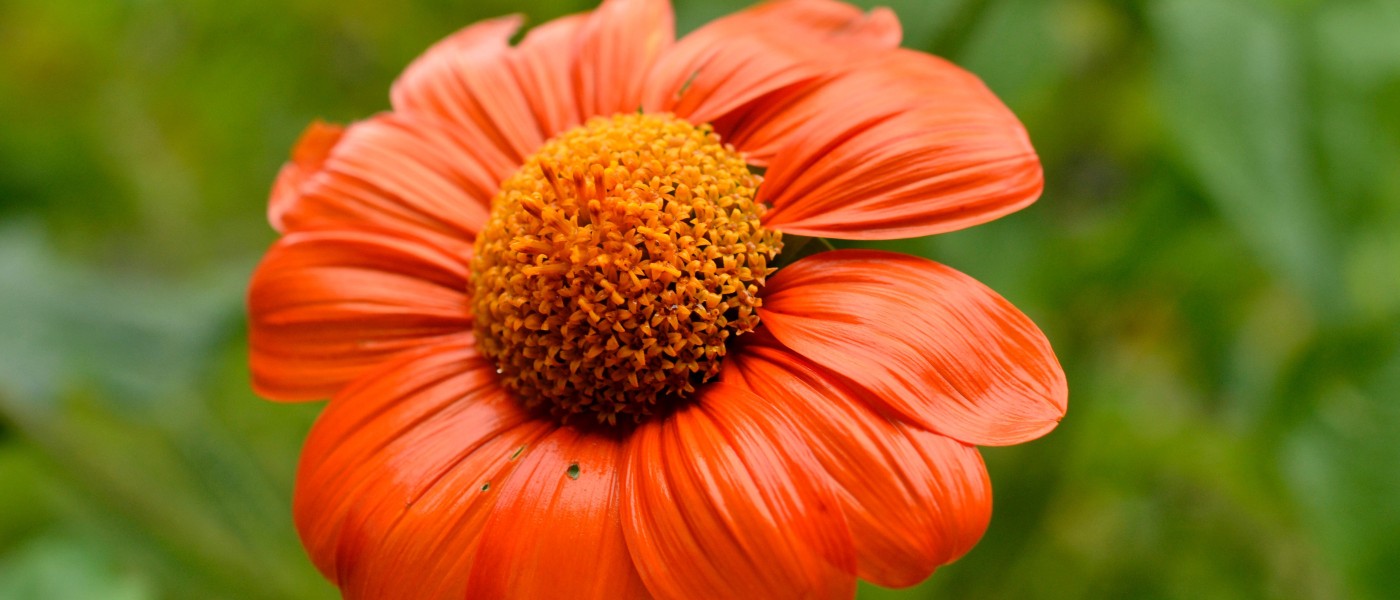Daisies of All Kinds
Ask a child to draw a flower and chances are you'll be presented with a daisy lookalike, a central disk surrounded by ray flowers. That's the hallmark of the aster family, Asteraceae, also known as the composite family, Compositae. There's enormous variation of flower color and size in this family—certainly something for everyone.
Mexican Sunflower (Tithonia rotundifolia)
Full Sun
Dry soil
Flower color: Vermilion rays and yellow disks
Height: 4'-6' Width: 3'-4'; plant 3' apart.
This is a tall, impressive annual. Leaves are large and covered with a velvety fuzz, and the 3- to 4-inch-wide flowers are bold and look lovely in a vase. The species is a long-season plant that blooms from late August until frost. It is heat-tolerant, endures drought and high humidity, and is rumored to be deer-resistant.
Growing Tips Start seeds indoors and move them outdoors as soon as the soil is warm. Germination takes about ten days. Mexican sunflower is not picky about soil quality.
Companion Plants For an unforgettable combination, try Tithonia rotundifolia next to Persian shield (Strobilanthes dyerianus) or Mexican bush sage (Salvia leucantha). The juxtaposition of orange and purple is dynamite.
Cultivars and Related Species Tithonia rotundifolia 'Fiesta del Sol' is considered dwarf at 28 to 36 inches in height. 'Torch' tops out at 6 feet tall.
Strawflower (Helichrysum bracteatum)
Full Sun
Dry soil
Flower color: Gold, copper, silver
Height: 24" Width: 12"; plant 12" apart.
Strawflowers look as if they were spun from precious metals, covering the top of the plant with buttons of color and creating a multihued effect of different-size flower heads. Blossoms are 2 inches wide when fully opened and are excellent for drying, keeping their color for years.
Growing Tips Strawflowers will bloom all summer long, thriving in the heat and self-seeding in sandy soil. Start seeds indoors six to eight weeks before the last frost in your area. If your growing season is at least 16 weeks, you may sow seeds directly in the garden after the danger of frost has passed.
Companion Plants The soft gray foliage of lavender cotton (Santolina chamaecyparissus) offers a muted contrast to the vivid strawflower. For a hot, tropical look, combine it with an equally bright colored Canna, such as C. 'Pretoria', or one of the brighter shrub verbenas (Lantana).
Cultivars and Related Species Bracteantha bracteata 'Bronze Gold' and 'Pink' are two metallic beauties. 'Golden Beauty' has bronze flowers with yellow tips.
Pot Marigold (Calendula officinalis)
Full Sun
Average soil
Flower color: Bright orange, yellow; quieter shades of apricot, yellow,
cream
Height: 12"-30" Width: 12"-18"; plant 8" apart.
Called pot marigold because it was once used in cooking, Calendula is not only a good container plant but also makes an easy, colorful groundcover or mass planting. The 2 ½- to 4 ½-inch blooms are good for cutting, and the petals can be tossed in salads or sprinkled on rice dishes for a touch of color. The bright green leaves are lance- to spoon-shaped.
Growing Tips This hardy annual prefers cool weather, adapts to most well-drained soils, and will happily self-seed. For spring bloom, start seeds very early indoors and set out as soon as the soil can be worked. For fall or winter bloom in warm regions, sow seeds in place outdoors and thin to 12 inches apart. The cut flowers are long lasting. Pot marigold is very susceptible to powdery mildew.
Companion Plants Purple-flowered sweet alyssum (Lobularia maritima 'Oriental Nights') adds a nice contrast to orange pot marigold. The hot colors of Nemesia strumosa 'Carnival' Series make pot marigold pop. Good foliage plants to combine with pot marigold include ornamental kale (Brassica oleracea) with creamy highlights and parsley (Petroselinum crispum).
Cultivars and Related Species Cultivars of Calendula officinalis 'Pacific Beauty' Series produce double flower heads in shades of apricot and cream as well as yellow and orange.
Golden Coreopsis (Coreopsis tinctoria)
Full Sun
Average soil
Flower color: Mahogany, yellow; yellow tips and mahogany bases
Height: 24"-36" Width: 12"; plant 12" apart.
The single or double flowers of this annual coreopsis are slightly more than an inch in diameter and work beautifully in cut-flower arrangements. The foliage is feathery and light.
Growing Tips Golden coreopsis is easy to grow and frequently self-sows. Plant seeds outdoors in early spring in well-drained soil; cold weather won't hamper germination. Coreopsis blooms best when crowded, so don't thin seedlings as they grow.
Companion Plants Try Coreopsis tinctoria with Geranium himalayense. The deep purple-blue flowers of the geranium provide striking contrast to those of this coreopsis. The upright flowers of speedwell (Veronica virginica and V. spicata) also mix well with the daisy-shaped bloom of Coreopsis.
Cultivars and Related Species Coreopsis tinctoria 'Mahogany Midget' is a dwarf cultivar with deep red blooms that grows 10 inches tall and wide. Other dwarf cultivars, excellent for containers, include 'Golden Sovereign' and 'Tiger Star'.
Cosmos (Cosmos bipinnatus)
Full Sun
Average soil
Flower color: White, pink, magenta, striped
Height: 5'-6' Width: 18"-24"; plant 18" apart.
Cosmos is an old-fashioned flower but by no means passŽ. The profuse feathery foliage adds wonderful texture to any garden. Blooms are about 2 inches in diameter. Cosmos is self-branching and makes a beautiful cut flower.
Growing Tips Plant seeds directly in average garden soil after danger of frost has passed, or start them indoors six weeks before transplanting. Plants may need to be staked as they get taller. Use fertilizer sparingly, if at all, as it promotes foliage growth at the expense of flowers. Deadhead regularly to promote season-long bloom. Cosmos frequently self-seeds.
Companion Plants The similar color of their flowers and contrasting foliage make Cosmos and Cleome excellent garden companions. Cosmos also mixes well with tall ornamental grasses such as feather reed grass (Calamagrostis x acutiflora 'Stricta').
Cultivars and Related Species Cosmos bipinnatus 'Seashell Mix' has rolled petals with an upward tilt. At just 2 feet tall, C. bipinnatus 'Sonata' is well suited for containers. C. sulphureus grows to 6 feet tall, and flowers are yellow or orange.
Blue Marguerite (Felicia amelloides)
Full Sun
Dry soil
Flower color: Blue rays and yellow disk
Height: 12"-24" Width: 18"-24"; plant 6" apart.

The color scheme of this plant is gorgeous. Many gardeners go out of their way to combine yellow and blue flowers in their gardens, and this plant accomplishes it for you. It's a cool-weather plant and flowers best before the dog days of summer. The flowers are approximately 1 ½ inches wide.
Growing Tips Blue marguerite grows best in well-drained soil. Start seeds indoors and move them outside after the last frost in your area. Conscientious deadheading and fertilizing every other week will keep blue marguerite blooming. Cut it back after the first round of flowering and you'll get a second crop in early fall.
Companion Plants The flowers of Coreopsis lanceolata mirror the center color of the blue marguerite and make a good garden companion. Or try planting blue marguerite next to a clump of yellow bearded iris.
Cultivars and Related Species Felicia amelloides 'Monstrosa' has much larger flowers, which measure up to 3 inches in diameter. 'Variegata' has cream-and-green-variegated foliage.
Creeping Daisy (Mauranthemum paludosum)
Full Sun
Average soil
Flower color: White rays and disk
Height: 8"-10" Width: 12"-15"; plant 10"-12" apart.
Sometimes called mini-marguerite, this species produces masses of 1- to 1 ½-inch-wide flowers that look like miniature shasta daisies (Leucanthemum x superbum). The leaves are dark green and deeply toothed. Because the plant blooms best in cool weather, it is used as a fall and winter annual in California, the Southwest, and the deep South; in the cooler areas of these regions, it may live and bloom a second year.
Growing Tips In areas where Mauranthemum paludosum is grown as a winter annual, young plants are usually available in early fall, but you can also sow the seed directly into well-draining soil or in containers in October, thinning the seedlings to 10 to 12 inches apart. In cool climates, sow the seed directly in the garden in spring. This plant self-seeds.
Companion Plants Mauranthemum paludosum makes a great spring bulb companion, first offsetting the bulb flowers, such as tulips, later hiding the declining foliage. It works equally well with pansy (Viola x wittrockiana) and Iceland poppy (Papaver nudicaule). Or use it as a miniature temporary hedge to surround brompton stock (Matthiola incana).
Cultivars and Related Species Leucanthemum multicaule has bright yellow flowers and is lower-growing with succulentlike foliage.
Black-Eyed Susan (Rudbeckia 'Sunset')
Full Sun
Dry soil
Flower color: Yellow, rust, orange, brown; combinations
Height: 12"-30" Width: 12"; plant 12" apart.
You may be familiar with the perennial black-eyed susans, but there are also several annual cultivars that offer a range of warm to fiery colors. Their showy flowers are up to 9 inches in diameter and resemble those of sunflowers but are generally smaller and slightly more refined. They make excellent cut flowers.
Growing Tips Sow seeds directly in the garden or start them indoors eight to ten weeks before the last frost. Black-eyed susans grow well in average soil. They transplant easily and are heat-tolerant.
Companion Plants The foxtail plumes of Asparagus densiflorus 'Myersii' and the striking black leaves of Colocasia esculenta 'Jet Black Wonder' offer two very different types of foliage to offset Rudbeckia 'Sunset'.
Cultivars and Related Species The perennial R. 'Green Wizard' is an exotic knockout with large black center disks surrounded by green petals.
Thread-Leaf Zinnia (Zinnia angustifolia), Mexican Zinnia (Z. linearis)
Full Sun
Dry soil
Flower color: White or orange rays; yellow-orange disk
Height: 8"-12" Width: 6"; plant 6" apart.
Zinnias may not be exotic, but there are very few flowers that give you more bang for your gardening buck. Thread-leaf zinnia is a single-flowered zinnia, and the simplicity of its 1 ½-inch flower is charming. These little guys are perfect for the front of the border; they also work well in arrangements. They are quite drought-tolerant and will bounce back from a fairly heavy wilt. Deadheading assures summer-long bloom.
Growing Tips Thread-leaf zinnia is easy to grow. Start seeds indoors six weeks before transplanting. Zinnia angustifolia grows well in average soil, and though plants are drought-tolerant, seedlings should not be allowed to dry out. Regular fertilizing improves flowering.
Companion Plants Thread-leaf zinnia combines well with other bright-colored annuals such as rose moss (Portulaca grandiflora) and many verbenas. Try clumps of them interplanted with licorice plant (Helichrysum petiolare 'Icicles').
Cultivars and Related Species Zinnia angustifolia 'Crystal White', 'Gold Star', and 'Orange Star' all have superb, clear colors. The Zinnia 'Profusion' series is slightly taller, growing 12 to 15 inches high.
Tagetes 'Lemon Gem', 'Tangerine Gem' · Marigolds
Full Sun
Average soil
Flower color: Yellow, orange
Height: 12" Width: 12"; plant 12" apart.

While you may be familiar with the run-of-the-mill marigold, these two cultivars offer the sunny border or pot something more interesting. Smaller, simpler flowers (about an inch in diameter) are much more delicate than the ubiquitous pom-poms, as is the light, airy foliage. Flowers are edible and make attractive garnishes for salads, desserts, and even iced tea.
Growing Tips Sow marigold seeds in your garden two to three weeks before the last frost. They benefit from rich soil and regular fertilizing as well as deadheading.
Companion Plants As with other marigold cultivars, their insect-repellant properties make these plants useful in an herb or vegetable garden. For an attractive foliage contrast, combine them with purple-leafed basils.
Cultivars and Related Species Tagetes patula 'Disco Mix' is another single marigold. It grows 8 to 10 inches tall, and the yellow, orange, and red flowers are 3 inches across.
Creeping Zinnia (Sanvitalia procumbens)
Full Sun
Average soil
Flower color: Bright yellow
Height: 6" Width: 8"; plant 6" apart.
This little gem is perfect for the front of the border or for hiding the edges of a window box. The numerous small flowers are either single or double, about ½ inch in diameter, and are held atop slim stems and leaves, creating a delicate effect that allows you to peek through the foliage to the middle of the border.
Growing Tips Start seeds indoors or sow them directly in the garden in well-drained soil. Deadhead regularly and fertilize every two weeks to ensure constant bloom. Creeping zinnia blooms in hot and cool weather alike. It sometimes sulks for a few hours after being transplanted but will perk up quickly if watered well. To ease the shock of transplant, consider starting these seeds in individual peat pots.
Companion Plants Mix creeping zinnia with Scaevola aemula 'Purple Fan' at the front of a container for an outstanding color combination. Against the dark, shiny leaves of Ajuga reptans 'Atropurpurea' or one of the purple-leafed coral bells (Heuchera) the flowers of creeping zinnia really stand out.
Cultivars and Related Species Sanvitalia procumbens 'Sunbini' is an improved variety that has single flowers and is reported to be more floriferous.


